Abstract
Arequipa, situated in the arid Atacama Desert, is experiencing significant biodiversity loss due to unchecked urban growth. This study presents the design of a Botanical Garden to address this issue by serving as a conservation center for native flora. A baseline assessment was conducted to evaluate meteorological conditions, soil properties, and the quality of treated wastewater from the “La Escalerilla” plant. The analysis revealed a semi-arid climate with low precipitation and suitable soil conditions. A total of 685 plant species were identified and proposed for conservation within the garden, with a high proportion of endemic species. To protect the future plant species, a living fence composed of 700 individuals was installed, considering resilient species such as Molle serrano (Schinus molle), Cantuta (Cantua buxifolia), and Huaranguillo (Tephrosia cinerea), which were installed at an average height of 50 cm and have grown to an average of 80 cm after 8 months. This study demonstrates the feasibility of establishing a botanical garden in Arequipa’s arid environment and serves as a model for future botanical garden projects in arid regions at the national and regional levels, providing a foundation for natural landscapes in urban areas.
1. Introduction
The number of plant species under threat exceeds the total number of described birds, mammal, reptile, amphibian, and fish species listed by the IUCN [1]. In the study by [2], threatened species in botanical gardens are assessed, using risk scores, as invasive exotic species have become the second greatest threat to global biodiversity loss.
Botanical gardens serve as vital centers for plant conservation, sustainable development, and societal well-being. As climate change increasingly threatens plant diversity [3], these spaces play a crucial role in safeguarding endangered species through ex situ conservation efforts, such as seed banks and germplasm collections [4,5,6,7]. However, many species cannot be conserved ex situ; therefore, the implementation of a botanical garden would facilitate the study of seed behavior through living collections or cryocollections [8]. By preserving genetic material, botanical gardens contribute to the long-term survival of plant species and support efforts to restore degraded ecosystems.
Beyond their conservation function, botanical gardens provide significant benefits to society. Studies have demonstrated their positive impact on emotional well-being, cognitive development, and environmental awareness [9,10]. These green spaces offer opportunities for people to connect with nature, reduce stress, and develop a deeper appreciation of biodiversity.
In addition to their ecological and social value, botanical gardens contribute to sustainable development. By incorporating green infrastructure and implementing water conservation strategies, these spaces can help mitigate the impacts of climate change and improve local environmental quality [11,12]. For example, wetland filtration systems and wastewater treatment initiatives enhance water quality and provide valuable ecosystem services [11].
To fulfill their mission of conservation, education, and research, botanical gardens must be carefully designed and managed. Sustainable practices, such as using native species, reducing pesticide use, and minimizing waste, are essential [13,14,15,16]. By incorporating these elements, botanical gardens can become more resilient to climate change and better meet the needs of both plants and people. Additionally, they play a crucial role in biosecurity by detecting and eradicating pests and identifying key threats, as demonstrated by [17].
Botanical gardens are invaluable assets for conservation, sustainability, and human well-being. By preserving plant diversity, promoting environmental education, and supporting sustainable development, these green spaces play a vital role in addressing global challenges. As we grapple with climate change and biodiversity loss, botanical gardens offer a promising path toward a more sustainable and equitable future, especially in cities like Arequipa, which face significant environmental challenges.
The significance of this study lies in its comprehensive approach to designing a botanical garden in the unique arid environment of Arequipa. By prioritizing biodiversity conservation, particularly of endemic species, and incorporating sustainable practices such as water reuse, this project serves as a model for addressing the challenges of urban expansion and environmental degradation in arid regions. The Botanical Garden will not only be a valuable resource for research and education but will also contribute to broader environmental sustainability and community well-being.
2. Materials and Methods
2.1. Area Delimitation
The study area is located in the district of Cerro Colorado, Arequipa. This region is characterized by very low rainfall (20–200 mm per year), with precipitation occurring primarily in January, February, and March, while the rest of the year remains dry. This aridity is due to Arequipa’s location at the edge of the Atacama Desert, one of the driest places on Earth. The coordinates of the study area are shown in Table 1.

Table 1.
Coordinates of the study area vertices.
2.2. Area Diagnosis Through Physical Baseline
A detailed evaluation of the 20 ha area of interest was conducted for the construction of the Botanical Garden on land adjacent to the “Escalerilla” Wastewater Treatment Plant (WWTP) in Cerro Colorado. This land was granted by SEDAPAR S.A. to the Catholic University of Santa María. Physical, geographical, and geological features were described through topographic surveys and the use of ArcGIS to characterize the area, including protected natural areas and fragile ecosystems. The physical baseline assessment included a meteorological evaluation, climate description, and identification of the nearest weather station, along with topographic and geological surveys. Additionally, hydrography and hydrology were analyzed, including the assessment of water quality from the La Escalerilla WWTP according to Maximum Permissible Limits. Finally, the soil was characterized based on its suitability for use, current land use, and quality, with detailed monitoring and analysis [18].
2.3. Characterization of the Biological Baseline
According to the Guide for the Preparation of the Baseline and the Guide for the Identification and Characterization of Environmental Impacts within the framework of the National Environmental Impact Assessment System (SEIA, 2018), the biological baseline assessment was conducted. As part of this process, the life zone to which the land assigned for the Botanical Garden belongs was determined. Additionally, an assessment of pre-existing species in the field was carried out to identify current plant diversity and gain a better understanding of the local ecosystem [18].
2.4. Design of the Botanical Garden
The type of Botanical Garden was designed with a focus on protecting native species at risk and creating a habitat for various species of trees, shrubs, cacti, orchids, and other plants of botanical importance. Endemic, endangered, medicinal, and regional, national, and international species were classified with the assistance of botanists, taking into account adaptation measures based on their family, endemism, conservation status, habitat, and bioclimate [19].
The garden’s layout was developed in AutoCAD 2023, incorporating greenhouses, nurseries, designated plant areas, composting zones, and administrative and training facilities, following prior adaptability studies. The zoning plan also considered industrial symbiosis with the “La Escalerilla” WWTP and the integration of an artificial wetland [10].
As the first step in the garden’s establishment, a living fence was installed to protect future plant species from wind and arid conditions. The species selected for this purpose were chosen based on their height range, endemism, and resilience.
3. Results
3.1. Digital Elevation Model of the Area
In the study area, the pre-existing infrastructure was identified, including the “La Escalerilla” Wastewater Treatment Plant (WWTP). The Botanical Garden is located on an adjacent 20-hectare plot. Additionally, the study included residential areas surrounding the WWTP and an artificial wetland at the effluent discharge point. The area supports diverse herbaceous flora and avifauna.
The Botanical Garden Project is situated in the Northern Cone area of the Cerro Colorado district, Arequipa, Peru. Figure 1 illustrates the project location and the corresponding digital elevation model. The study area encompasses slopes ranging from 5% to 10%.
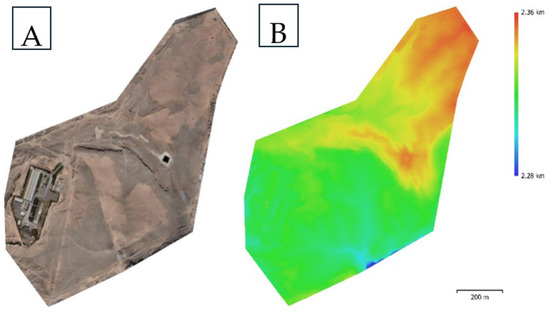
Figure 1.
Project location area. (A). Project area with the WWTP to the west. (B). Digital elevation model of the area.
3.2. Physical Baseline
3.2.1. Climatic Conditions
Meteorological data on temperature, precipitation, and relative humidity were obtained from the nearest weather station (La Pampilla), whose information is public (Table 2).

Table 2.
Meteorological data in the study area.
The climate in the study area is characterized by moderate temperatures, with no extreme highs or lows, minimal rainfall, and low humidity levels.
3.2.2. Hydrography and Hydrology
The study area is located approximately 0.25 km from the Seco River and 0.8 km from an unnamed creek (S/N 01), which serves as a tributary of the Seco River. However, no lakes or lagoons are present near the Botanical Garden.
The affluent that enters the Wastewater Treatment Plant (WWTP) consists of wastewater from the population of the Cerro Colorado district, which contains various pollutants. The resulting values indicate the presence of thermotolerant coliforms, which, though minimal, are related to dissolved oxygen levels. When comparing the results with the Maximum Permissible Limits (MPLs) established by Supreme Decree No. 003-2010-MINAM, the findings indicate that pollutant levels do not exceed the regulatory limits, confirming that the treatment process is being conducted effectively (Table 3). However, when evaluated against Supreme Decree No. 015-2015-MINAM, which defines the water quality standards for irrigating crops within Category 3, Subcategory D1, the following results are observed:

Table 3.
Comparison of mean effluent values with MPLs and EQS.
Based on Table 3 the wastewater from the La Escalerilla WWTP is mostly suitable for irrigation in the Botanical Garden. However, the biochemical oxygen demand (BOD) and chemical oxygen demand (COD) values slightly exceed Environmental Quality Standards, indicating an increase in organic load. To address this issue, it is proposed to incorporate a phytoremediation wetland within the Botanical Garden. This wetland, composed of aquatic species and microorganisms, will facilitate phytopurification, effectively removing pollutants and degrading elevated parameters, providing a sustainable and efficient water purification solution.
3.2.3. Physical, Geographical, and Geological Characteristics
The study area is characterized by a barren landscape with gentle slopes ranging from 5% to 10%, interspersed with minor sinusoidal formations adjacent to the Añashuayco geosystem.
Geologically, the region consists of a stratigraphic sequence of metamorphic, sedimentary, volcano-sedimentary, and intrusive rocks from the Coastal Batholith, spanning from the Precambrian to the Quaternary. Structurally, the area is defined by a network of fractures, major faults, and secondary fractures, predominantly oriented northwest–southeast and northeast–southwest.
The Botanical Garden will be established on geoforms shaped by degradational and denudational tectonic processes. These landforms have evolved through the progressive erosion of initial tectonic reliefs under the influence of morphodynamic processes or through the modification of gradational landforms shaped by exogenous processes. The project is specifically located on a volcanic unit characterized by pyroclastic flow deposits.
3.2.4. Soils, Main Use Capacity, Current Use, and Soil Quality
- A.
- Soils: The study area consists of andosols found in undulating to mountainous regions, primarily composed of volcanic ash, with AC- or ABC-type profiles.
- B.
- Land Classification: The area is classified as Protected Lands, suitable for the permanent cultivation of high-agrological-quality crops, requiring proper management and conservation practices.
- C.
- Current land use: The area is unvegetated and classified as coastal plains and Andean foothills without vegetation, according to the International Geographical Union (IGU).
- D.
- Soil quality: Soil properties were analyzed from a representative soil sample taken from the area, with the results detailed in Table 4.
 Table 4. Results of soil analysis.
Table 4. Results of soil analysis.
The percentages of the soil analysis indicate a sandy loam texture. Therefore, the soils where the project will be implemented offer multiple benefits, since their good permeability contributes to the correct drainage of water. This ensures that the water allocated for the irrigation of the species is not wasted.
Table 4 shows the soil analysis, which indicates moderate salinity (EC: 2.55 dS/m) and a slightly acid pH (5.47), which may affect nutrient availability. The organic matter content (2.40%) is low, as are the levels of phosphorus (<6 mg/kg) and potassium (61.65 ppm), suggesting a need for nutrients.
3.3. Classification of Flora Species
In the project area, the species Cumulopuntia sphaerica and Baccharis latifolia were randomly distributed. The design of the Botanical Garden includes the classification of 685 plant species, selected based on their ecological relevance, conservation status, and adaptation to Peru’s bioclimatic conditions. This selection was conducted through a rigorous taxonomic and ecological analysis with the collaboration of biologists and botanists, prioritizing endemic species and those classified as endangered to strengthen local biodiversity conservation. Representative species from the country’s major ecosystems were included, ensuring their viability in a controlled and suitable environment for their development. Additionally, functional criteria were considered, such as their contribution to soil restoration, erosion control, and air quality improvement. Thus, the classification of these species will not only serve as a biodiversity reservoir but will also contribute to the advancement of botanical studies, reforestation programs, and the promotion of knowledge on species with medicinal and ornamental potential.
3.4. Distribution and Zoning of the Botanical Garden
The Botanical Garden design, developed in collaboration with specialists, includes 28 zones, of which 19 will feature 685 plant species. These species have been grouped according to their endemism (Figure 2) and conservation status (Figure 3). Many of these plants contribute to improving water availability and adapting to diverse microclimates, enhancing the resilience and sustainability of the garden.
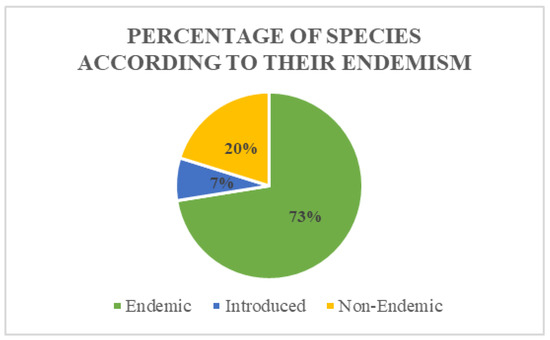
Figure 2.
Distribution of species by endemism. Source: Red Book of Peru’s Endemic Plants [20].
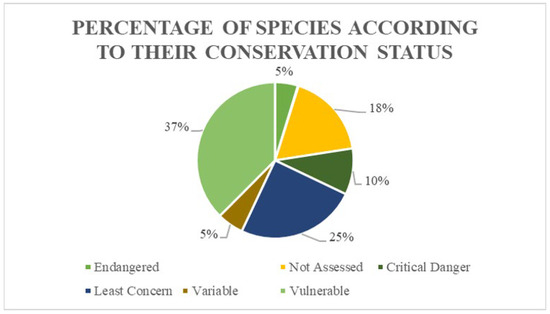
Figure 3.
Distribution of species by conservation status. Source: Red Book of Peru’s Endemic Plants [20].
Figure 2 shows that most species are endemic (73%), followed far behind by non-endemic species (20%) and introduced species (7%). Notably, they were classified according to the Red Book and previous botanical records, facilitating the identification of their distribution. Additionally, while it is known that introduced species can spread easily, they also contribute to ecosystem homogenization. In this regard, they were considered for inclusion in the Botanical Garden, as they possess ornamental, medicinal, and aromatic properties, complementing the species collection.
On the other hand, Figure 3 reveals the conservation status of the species in the Botanical Garden. It shows that 5% are endangered, 0.1473% are at risk, 18% have not been assessed, and 10% are in critical danger. A quarter, 25%, are of least concern, and 5% have a variable status. The largest group, 38%, are vulnerable, meaning they are at risk of becoming endangered without proper conservation efforts.
The garden design, based on the Ministry of Environment’s Vegetation Cover Map, prioritizes the protection of endemic species while promoting ecological and conservation research. Additionally, it includes designated areas for medicinal plants, a floral hedge, fruit trees, and an organic vegetable garden to foster environmental awareness (Table 5 and Figure 4).

Table 5.
Zoning of the Botanical Garden.
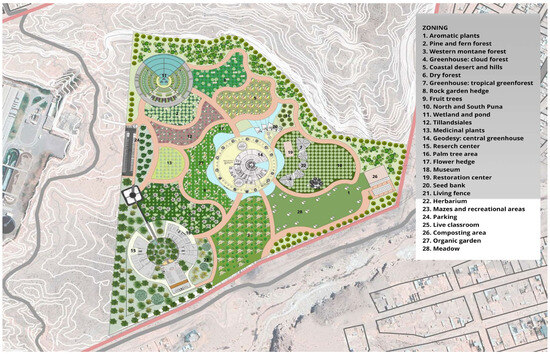
Figure 4.
Zoning of the Botanical Garden.
As shown in Figure 4, the 28 zones are carefully distributed across the study area. This perspective also highlights the crucial role of the WWTP in providing water to this arid region. It is important to highlight that a zone of spontaneous species will be included in those areas of the Botanical Garden where no established zone exists. In this area, the species that were removed from the project site will be relocated, with the aim of allowing these species to re-establish themselves in their natural habitat, contributing to their conservation and promoting their reintegration into the original ecosystem.
3.5. Living Fence
The living fence is distinguished by its rapid growth, adaptability to diverse soil types, and high drought tolerance. These characteristics significantly reduce the need for frequent irrigation, thus lowering maintenance costs and minimizing water consumption. Given its critical role in protecting the garden from wind and arid conditions, the installation of the living fence has been prioritized as the first implementation step. In this regard, a specific number of plants were placed along the perimeter (Figure 5), and according to monitoring data, they exhibit the following characteristics (Table 6).
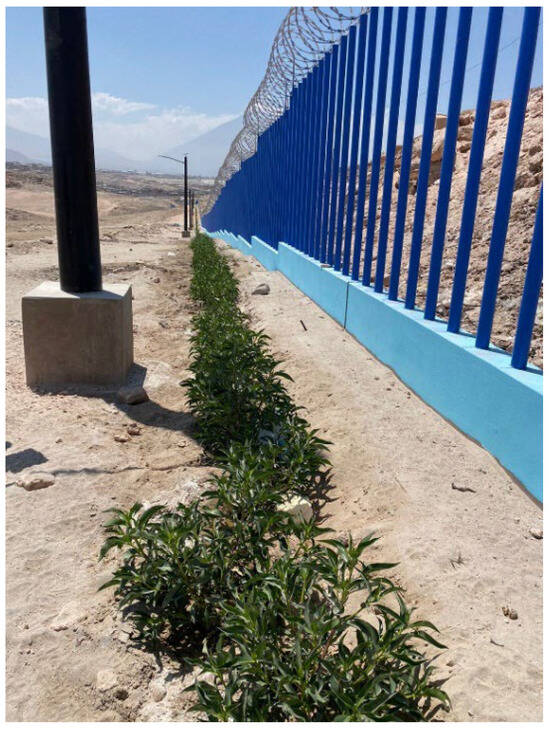
Figure 5.
Living fence.

Table 6.
Species for the living fence.
The living fence is primarily composed of Molle Serrano, Molle Costero, and Jacaranda species, which display greater vigor and height. In contrast, species such as Yaro, Cahuato, Huarango, and Tara, which are less abundant and smaller in size, are found in lower proportions.
4. Discussion
It is of vital importance to highlight that climate, soil, and water were evaluated for the design of the Botanical Garden, as this assessment facilitated species selection and their viability within the environment. Additionally, the climate analysis identified the optimal conditions for plant development, the soil study determined the water and nutrient retention capacity of the species, and the water quality assessment was essential to ensure its efficient use for irrigation, making the garden more sustainable.
In this regard, it is noted that the effluent values exceed EQA in BOD and COD, it is proposed to treat the water before entering the garden. Ref. [21] claims that phytoremediation is an effective method of reducing pollutants, and that artificial wetlands are very useful. Ref. [22] indicates that the wetland would function as a black box, as interactions between plant roots and microorganisms would occur. Therefore, more research on these interactions is needed to develop a more robust, effective, and efficient model.
On the other hand, ref. [23] indicates that aluminum toxicity and low phosphorus availability inhibit legume growth, which could explain the sparse vegetation in the area. Additionally, the soil–root interface is the primary zone where plants absorb both water and nutrients. Ref. [21] highlights that microorganisms form symbiotic relationships, primarily mycorrhizae, which enhance nutrient bioavailability. However, in acidic soils, the activity of these microorganisms can decline, negatively affecting plant growth.
Our findings confirm the presence of nitrogen in the acidic soil, emphasizing the role of organic matter and microbial activity in nutrient cycling [24]. Although heavy metal concentrations were low, their potential mobility in acidic conditions warrants attention [25]. To enhance soil fertility and adjust pH, amendments such as compost can improve soil properties and create a more favorable environment for plant growth [26]. Additionally, the relationship between soil moisture and texture suggests potential for optimizing irrigation strategies [27]. By implementing these strategies, we can improve soil health and support sustainable plant growth.
Botanical gardens play a crucial role in biodiversity conservation, scientific research, and education [28]. By monitoring plant responses to climate change, they contribute valuable long-term data [29]. To ensure the survival of threatened species, continuous monitoring and adaptation strategies are essential [30]. Thus, the design of the Botanical Garden will include a seed bank dedicated to the conservation and preservation of seeds and species that are under threat, ensuring their monitoring and development. This will enable the reintroduction of species into their native habitats. Therefore, seed banks are fundamental to the conservation efforts of botanical gardens, facilitating the exchange of genetic material and collaboration among institutions [31]. By addressing global challenges such as climate change and biodiversity loss, botanical gardens contribute to Sustainable Development Goals 2, 4, 11, and 13, promoting environmental, social, economic, and institutional benefits.
5. Conclusions
The results of this study demonstrate the feasibility of establishing a botanical garden in an arid urban environment, such as Arequipa, using treated wastewater. Beyond providing a green space for the community, this initiative represents a significant advancement in biodiversity conservation in water-scarce environments.
The analysis of the physicochemical parameters of water and soil suggests the need for some improvements. However, the overall conditions are conducive to plant growth, supporting the feasibility of using treated wastewater for gardening and landscaping projects in areas with similar environmental conditions.
This study sets an important precedent for future initiatives, not only in Arequipa but also at national and regional levels. By demonstrating the possibility of creating an oasis of biodiversity in an arid urban environment while utilizing unconventional water resources, this research opens new possibilities for sustainable urban planning and nature conservation in semi-arid regions of South America.
Author Contributions
Formal analysis, M.E.B.M. and A.M.C.M.; Methodology, G.M.P.C. and P.F.V.M.; Project administration, M.E.B.M.; Supervision, M.E.B.M. and A.M.C.M.; Writing—original draft, M.E.B.M., G.M.P.C. and P.F.V.M.; Writing—review and editing, M.E.B.M. and A.M.C.M. All authors have read and agreed to the published version of the manuscript.
Funding
The funder is the Universidad Católica de Santa María and the funding was approved by Resolution N°30248-R-2024.
Institutional Review Board Statement
Not applicable.
Informed Consent Statement
Not applicable.
Data Availability Statement
Data supporting this study are available upon request addressed to the corresponding author.
Acknowledgments
We would like to extend our sincere gratitude to Miguel Hinojosa, Josué Llanque Chana, and Luis Valderrama Luque for his invaluable contribution to this study, as well as Magda Bermúdez Valero and Martha Perdomo Ramírez from the Botanical Garden of Bogotá for sharing her experience in this project. Finally, we would like to thank Lorenzo Carrasco Valencia for his contribution in the preparation and management of the manuscript.
Conflicts of Interest
The authors declare no conflicts of interest.
References
- Westwood, M.; Cavender, N.; Meyer, A.; Smith, P. Botanic garden solutions to the plant extinction crisis. Plants People Planet 2021, 3, 22–32. [Google Scholar] [CrossRef]
- Junaedi, D.I.; Nasution, T.; Putri, D.M.; Iryadi, R.; Lestari, R.; Kurniawan, V.; Handayani, A. Threatened exotic species of botanical gardens: Application of trait-based naturalized species risk scoring assessment. South Afr. J. Bot. 2023, 152, 321–331. [Google Scholar] [CrossRef]
- Davis, B.M. Building engineered wetlands to reduce costs. Pollut. Eng. 2009, 12. [Google Scholar]
- Thomas, G.; Sucher, R.; Wyatt, A.; Jiménez, I. Ex situ species conservation: Predicting plant survival in botanic gardens based on climatic provenance. Biol. Conserv. 2022, 265, 109410. [Google Scholar] [CrossRef]
- Zhao, X.; Chen, H.; Wu, J.; Ren, H.; Wei, J.; Ye, P.; Si, Q. Ex situ conservation of threatened higher plants in Chinese botanical gardens. Glob. Ecol. Conserv. 2022, 38, e02206. [Google Scholar] [CrossRef]
- Ulian, T.; Pritchard, H.W.; Cockel, C.P.; Mattana, E. Enhancing food security through seed banking and use of wild plants: Case Studies from the Royal Botanic Gardens, Kew. Encycl. Food Secur. Sustain. 2018, 3, 6. [Google Scholar] [CrossRef]
- O’Donnell, K.; Sharrock, S. The contribution of botanic gardens to ex situ conservation through seed banking. Plant Divers. 2017, 39, 373–378. [Google Scholar] [CrossRef]
- Philpott, M.; Pence, V.C.; Bassüner, B.; Clayton, A.S.; Coffey, E.E.D.; Downing, J.L.; Edwards, C.E.; Folgado, R.; Ligon, J.J.; Powell, C.; et al. Harnessing the power of botanical gardens: Evaluating the costs and resources needed for exceptional plant conservation. Appl. Plant Sci. 2022, 10, e11495. [Google Scholar] [CrossRef] [PubMed]
- Błaszak, M.; Rybska, E.; Tsivitanidou, O.; Constantinou, C.P. Botanical gardens for productive interplay between emotions and cognition. Sustainability 2019, 11, 7160. [Google Scholar] [CrossRef]
- Yilmaz, S.; Vural, H.; Yilmaz, H. Effects of botanical gardens on student environmental perception. Ecol. Inform. 2023, 73, 101942. [Google Scholar] [CrossRef]
- Entwisle, T.J.; Cole, C.; Symes, P. Adapting the botanical landscape of Melbourne Gardens (Royal Botanic Gardens Victoria) in response to climate change. Plant Divers. 2017, 39, 338–347. [Google Scholar] [CrossRef] [PubMed]
- Theepharaksapan, S.; Ittisupornrat, S.; Ketbubpha, K.; Phattarapattamawong, S.; Boonnorat, J. Municipal wastewater treatment processes for sustainable development. In Integrated and Hybrid Process Technology for Water and Wastewater Treatment; Elsevier: Amsterdam, The Netherlands, 2021; pp. 517–535. [Google Scholar] [CrossRef]
- Musielok, Ł.; Drewnik, M.; Stolarczyk, M.; Gus, M.; Bartkowiak, S.; Kożyczkowski, K.; Lasota, J.; Motak, A.; Szczechowska, K.; Wątły, M. Rates of anthropogenic transformation of soils in the Botanical Garden of Jagiellonian University in Kraków (Poland). Catena 2018, 170, 272–282. [Google Scholar] [CrossRef]
- Rayan, M.; Gruehn, D.; Khayyam, U. Green infrastructure indicators to plan resilient urban settlements in Pakistan: Local stakeholder’s perspective. Urban Clim. 2021, 38, 100899. [Google Scholar] [CrossRef]
- Lopez, A.; Bunsha, D.; Austin, D.; Caddy, L.; Douglas, J.; Hill, A.; Kubeck, K.; Lewis, P.; Stormes, B.; Sugiyama, R.; et al. Aligning to the UN Sustainable Development goals: Assessing contributions of UBC botanical Garden. Sustainability 2022, 14, 6275. [Google Scholar] [CrossRef]
- Li, Y.; Li, S.; Wang, C. Spatiotemporal evolution of Chinese botanical gardens over the last 5000 years. Sustainability 2022, 14, 15806. [Google Scholar] [CrossRef]
- Wondafrash, M.; Wingfield, M.J.; Wilson, J.R.; Hurley, B.P.; Slippers, B.; Paap, T. Botanical gardens as key resources and hazards for biosecurity. Biodivers. Conserv. 2021, 30, 1929–1946. [Google Scholar] [CrossRef]
- SENACE. Descripción de Proyecto y Linea Base. 2018. Available online: https://www.senace.gob.pe/wp-content/uploads/2018/10/4-y-5-LINEA-BASE.pdf (accessed on 14 January 2025).
- Botanic Gardens Conservation International. BGCI Accreditation (2.a ed.). 2022. Available online: https://www.bgci.org/wp/wp-content/uploads/2019/04/BGA-Standards-Manual-2.0.pdf (accessed on 14 January 2025).
- León, B.; Roque, J.; Ulloa, C.U.; Pitman, N.; Jorgensen, P.M.; Cano, A. (Eds.) Red Book of Peru’s Endemic Plants; Universidad Nacional Mayor de San Marcos, Facultad de Ciencias Biológicas: Lima, Peru, 2006; Volume 13. [Google Scholar]
- Zhang, B.Y.; Zheng, J.S.; Sharp, R.G. Phytoremediation in engineered wetlands: Mechanisms and applications. Procedia Environ. Sci. 2010, 2, 1315–1325. [Google Scholar] [CrossRef]
- Yuliasni, R.; Kurniawan, S.B.; Marlena, B.; Hidayat, M.R.; Kadier, A.; Ma, P.C. Recent progress of phytoremediation-based technologies for industrial wastewater treatment. In Phycoremediation Processes in Industrial Wastewater Treatment; CRC Press: Boca Raton, FL, USA, 2023; pp. 21–41. [Google Scholar]
- Wen, Z.; Yang, M.; Han, H.; Fazal, A.; Liao, Y.; Ren, R.; Yang, Y. Mycorrhizae enhance soybean plant growth and aluminum stress tolerance by shaping the microbiome assembly in an acidic soil. Microbiol. Spectr. 2023, 11, 03310-22. [Google Scholar] [CrossRef]
- Osafo, N.O.-A.; Jan, J.; Porcal, P.; Borovec, J. Contrasting catchment soil pH and Fe concentrations influence DOM distribution and nutrient dynamics in freshwater systems. Sci. Total Environ. 2023, 858, 159988. [Google Scholar] [CrossRef]
- Mayanna, S.; Peacock, C.L.; Schäffner, F.; Grawunder, A.; Merten, D.; Kothe, E.; Büchel, G. Biogenic precipitation of manganese oxides and enrichment of heavy metals at acidic soil pH. Chem. Geol. 2015, 402, 6–17. [Google Scholar] [CrossRef]
- Yu, M.; Zhang, J.; Wei, L.; Wang, G.; Dong, W.; Liu, X. Impact of soil textures on agricultural drought evolution and field capacity estimation in humid regions. J. Hydrol. 2023, 626, 130257. [Google Scholar] [CrossRef]
- Mi, H.; Shen, C.; Ding, T.; Zheng, X.; Tang, J.; Lin, H.; Zhou, S. Identifying the role of array electrodes in improving the compost quality of food waste during electric field-assisted aerobic composting. Bioresour. Technol. 2023, 388, 129763. [Google Scholar] [CrossRef] [PubMed]
- Wyse Jackson, P.; Sutherland, L.A. Role of botanic gardens. In Encyclopedia of Biodiversity; Elsevier: Amsterdam, The Netherlands, 2017. [Google Scholar]
- Primack, R.B.; Miller-Rushing, A.J. The role of botanical gardens in climate change research. New Phytol. 2019, 182, 303–313. [Google Scholar] [CrossRef] [PubMed]
- Donaldson, J.S. Botanic gardens science for conservation and global change. Trends Plant Sci. 2009, 14, 608–613. [Google Scholar] [CrossRef]
- Oruç, N.E.; Çahantimur, A.I. Beyond a garden: Alignment of Sustainable Development Goals with botanic gardens. Environ. Sci. Policy 2024, 152, 103639. [Google Scholar] [CrossRef]
Disclaimer/Publisher’s Note: The statements, opinions and data contained in all publications are solely those of the individual author(s) and contributor(s) and not of MDPI and/or the editor(s). MDPI and/or the editor(s) disclaim responsibility for any injury to people or property resulting from any ideas, methods, instructions or products referred to in the content. |
© 2025 by the authors. Licensee MDPI, Basel, Switzerland. This article is an open access article distributed under the terms and conditions of the Creative Commons Attribution (CC BY) license (https://creativecommons.org/licenses/by/4.0/).